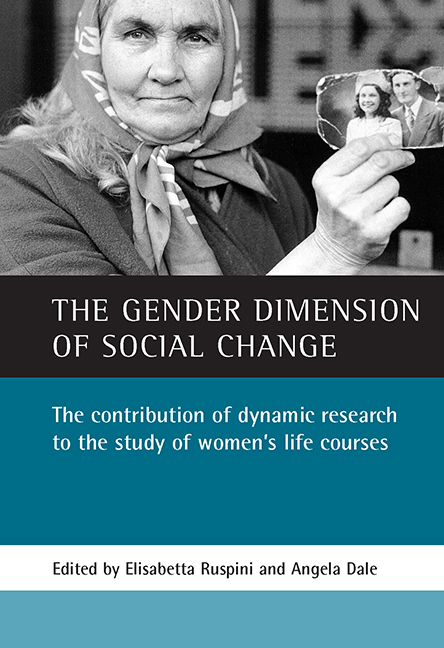 The Gender Dimension of Social Change
The Gender Dimension of Social Change one - Introduction
Published online by Cambridge University Press: 20 January 2022
Summary
This volume was developed from the Fifth International Conference on Logic and Methodology: Social Science Methodology in the New Millennium, Cologne, 3-6 October 2000, at which a session was organised by Elisabetta Ruspini ‘Engendering longitudinal data analysis: the contribution of dynamic research to the study of women’s life courses’. The session intended to explore the potential of longitudinal research as a powerful tool for appreciating the gender dimension of social life. The papers presented at the conference all used a longitudinal, gender-sensitive and comparative research approach; moreover, they all focused on issues where gender differences are central: employment, family changes, motherhood, poverty, social exclusion, income. Finally, they used a number of different longitudinal data sources: from repeated cross-sectional surveys to household panel studies, from cohort studies to retrospective interviews.
The topic of how to engender longitudinal analysis is of much interest and still largely unexplored: thus the editors collected the papers together in one volume, aimed at making explicit the importance of a longitudinal perspective in understanding gender differences and their evolution over time.
The gender dimension of social change is an innovative book – written for social scientists interested in the systematic empirical investigation of social change – which examines gender transformations from a comparative, international perspective and introduces the reader to dynamic research, demonstrating its contribution to the analysis of women’s and men’s life courses and public policy formulation. Another aim of the book is to provide new evidence for those interested in gender differences and in the gender dimension of social life, providing also a transparent account of the gender dimension of social inequality. Finally, the book is an invitation for those who wish to carry out their own research to launch their own longitudinal, gender-sensitive research project. While the level of statistical complexity varies between chapters, all authors have included a methods section aimed at giving a clear account of why they adopted a particular method, of its strengths and limitations, of the data requirements and of the statistical assumptions. In order to encourage the use of longitudinal data, we believe there is a strong need to exchange information between researchers and scientists, those who already perform longitudinal research, those who are approaching it, or those who would like to perform it but do not yet know how.
- Type
- Chapter
- Information
- The Gender Dimension of Social ChangeThe Contribution of Dynamic Research to the Study of Women's Life Courses, pp. 3 - 10Publisher: Bristol University PressPrint publication year: 2002
